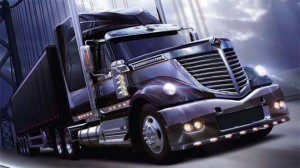Having reached a compromise that will nearly double the fuel economy of the typical passenger vehicle over the next 14 years, the Obama Administration is now taking aim at some of the nation’s biggest gas-guzzlers.
The White House is scheduled to announce first-ever fuel economy standards for big trucks – which could mean cutting gas consumption by as much as 23% by 2018. The rules, which will be announced later today, will cover everything from 18-wheel semis to garbage and fire trucks – as well as the heav-duty versions of pickups like the Ford F550, which aren’t included in the mileage rules announced late last month.
Administration officials expect the new rules to more than pay off in terms of reduced fuel bills – while also slashing the production of greenhouse gases and other noxious emissions. Preliminary estimates indicate vehicles meeting the new standards will ultimately save about 530 million barrels of oil which, at anticipated prices after the current economic downturn, could be worth more than $50 billion.
The new standards, which will cover the years 2014 through 2018, will impact three categories of vehicles:
- Semi trucks will be required to reduce fuel consumption by 23%;
- Work trucks, which include concrete mixers, buses and fire trucks, will have to target a 9% improvement;
- Heavy-duty pickups and vans will be required to boost mileage by 10% if they run on gas, and 15% if they use diesel.
Administration officials acknowledged that for some products, the cost of meeting the new standards could come to thousands of dollars per vehicle.
The truck industry has already been pushing for greener technologies. Bus manufacturers, for example, have been rolling out a variety of hybrid-electric and natural gas-powered models which are becoming increasingly common in many major cities.
Hybrid technology is beginning to find applications in medium and even heavy-duty trucks and vans, while pure battery-electric offerings are now reaching market. Ford, for example, launched a battery-based version of its Transit Connect van early this year. And it recently announced a deal with Canadian Azure Dynamics to develop a plug-in version of the big F550 pickup.
Semi maker Navistar, meanwhile, is investigating the potential application of a radically different engine design, dubbed the OPOC, which could markedly improve the performance of the company’s long-distance haulers.
A formal announcement of the new rules will come at a truck industry meeting in Virginia.
It follows the administration’s announcement that the Corporate Average Fuel Economy, or CAFE, standard will be raised to 54.5 mpg by 2025. That’s roughly double where the mandate stood when President Obama took office, and will require automakers to achieve a roughly 3% annual increase from the 37.5 mpg standard now in place for 2016.


While there is still some room for fuel economy improvement in passenger cars and light duty trucks, the low hanging fruit, high hanging fruit, and most of the fruit tree are all long gone in the commercial truck segment.
Ever since the first major oil shock in the seventies, truck builders and buyers have been chasing every possible fraction of fuel economy.
A few extra miles per gallon on a car is a nice bonus, but when you have 1,000 trucks traveling 100K miles/year, improvements of as little as 0.01 MPG can add up to the difference between profit or loss for a fleet owner.
As one comment seen elsewhere this morning put it, “Insisting that truck owners improve fuel economy is akin to mandating that bears (dump) in the woods.”
I’ve yet to hear any specifics about the testing regimen for these standards, but given the diversity of applications and equipment involved, any practical regimen is likely to be ineffective, and any effective regimen is likely to be impractical.
The engines themselves are already at the bleeding edge, hence the call for a vehicle based standard, but the proposed breakdown into three categories is analogous to sorting every marine vessel from a towable fishing boat to an aircraft carrier into just a few categories.
Perhaps if the 15% excise tax levied on all new commercial trucks was waived for the cost of marginal ROI fuel efficiency (and advanced safety) options, that could incentivize a stepped-up modernization of many fleets.
There are plenty of ways to cut truck fuel consumption that don’t involve the truck’s design at all, but where’s the fun if something isn’t being regulated?
I can think of at least one way that heavy truck fuel consumption can be cut dramatically in less than six months. If we could coax UMTRI or somebody to crunch the numbers and compare, I’d be willing to bet a nice dinner that my method would work better than the proposed standards.
Good points, Tom,
But I think that, as with passenger vehicles, we may yet see some unexpected yields of fruit. And there are a number of new technologies that could yet come along, as I noted in the story, to achieve still more gains. The short-term nature of the proposed increases seems the biggest obstacle.
Paul A. Eisenstein
Publisher, TheDetroitBureau.com